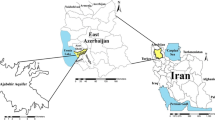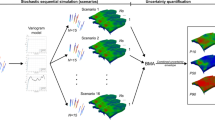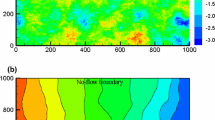Abstract
Uncertainty in groundwater modeling presents a significant challenge, originating from various sources. This groundbreaking study aims to quantitatively assess uncertainties arising from spatial discretization and complexity dynamics. The research focuses on the Najafabad Aquifer in Esfahan, Iran, as a compelling case study. Five distinct conceptual models were developed, with parameter counts of 16 (model 1), 20 (model 2), 22 (model 3), and 26 (model 4 and 5), and subjected to a consistent spatial discretization of 500 m. Additionally, two alternative models with spatial discretizations of 250 m (model 1a) and 1000 m (model 1 b) were introduced based on the least complex model with 16 parameters. The study comprehensively examines groundwater uncertainty by manipulating spatial discretization while considering complexity dynamics. Model Muse facilitates simulation, and UCODE is utilized for calibration using observed hydraulic head data. Uncertainties are explored using Bayesian model-averaging (BMA) and model selection criteria. Comparing probabilities of the initial five models reveals increasing uncertainty with a greater number of parameters (KIC in model 1: 99.25%, model 2: 0.41%, model 3: 0.34%, model 4 and 5: 0%). Investigation of seven alternative models highlights the dominant influence of coarser spatial discretization on groundwater modeling uncertainty. Remarkably, despite the lowest complexity in model 1 with probability of 99.25%, the model with coarse spatial discretization (model 1b) exhibits the zero probability (KIC in model 1a: 93.42%, model 1: 6.53%, model 1b: 0%, model 2: 0.03%, model 3: 0.02%, model 4 and 5: 0%.). Thus, considering optimal parameter count and spatial discretization size is crucial in conceptual model development. This study pushes the boundaries of understanding the intricate relationship between spatial discretization, complexity, and groundwater modeling uncertainty. Findings hold significant implications for improving model accuracy and decision-making in hydrogeological studies.






Similar content being viewed by others
Data availability
The data that support the findings of this study are publicly available and can be accessed at: http://wrs.wrm.ir/amar/register.asp. In addition, Model Muse and Model Mate software that applied in this study are open source and can be accessed at: https://water.usgs.gov/water-resources/software/ModelMuse/https://water.usgs.gov/software/ModelMate/
References
Akaike H (1974) A new look at the statistical model identification. IEEE Trans Autom Control 19(6):716–723
Bomers A, Schielen RMJ, Hulscher SJ (2019) The influence of grid shape and grid size on hydraulic river modelling performance. Environ Fluid Mech 19(5):1273–1294
Chen B, Harp DR, Lu Z, Pawar RJ (2020) Reducing uncertainty in geologic CO2 sequestration risk assessment by assimilating monitoring data. Int J Greenhouse Gas Control 94:102926
Choubin B, Hosseini FS, Rahmati O, Youshanloei MM (2023) A step toward considering the return period in flood spatial modeling. Nat Hazards 115(1):431–460
Diks CG, Vrugt JA (2010) Comparison of point forecast accuracy of model averaging methods in hydrologic applications. Stoch Env Res Risk Assess 24(6):809–820
Downer CW, Ogden FL (2004) Appropriate vertical discretization of Richards’ equation for two-dimensional watershed-scale modelling. Hydrol Process 18(1):1–22
Duan Q, Ajami NK, Gao X, Sorooshian S (2007) Multi-model ensemble hydrologic prediction using Bayesian model averaging. Adv Water Resour 30(5):1371–1386
Emberger F (1969) Climatique la Tunisia. Instituto Agronomico perl’Oltremare, Florence, pp 31–52
Enemark T, Madsen RB, Sonnenborg TO, Andersen LT, Sandersen PB, Kidmose J, Høyer AS (2024) Incorporating interpretation uncertainties from deterministic 3D hydrostratigraphic models in groundwater models. Hydrol Earth Syst Sci 28(3):505–523
Engelhardt I, De Aguinaga JG, Mikat H, Schüth C, Liedl R (2014) Complexity vs. simplicity: groundwater model ranking using information criteria. Groundwater 52(4):573–583
Environmental simulations Inc (ESI), (2007) Guides to using ground water vista. Version 5, pp 372
Gogineni A, Chintalacheruvu MR (2023). Streamflow assessment of mountainous river basin using SWAT model. In: International conference on science, technology and engineering. Singapore: Springer Nature Singapore, pp 1–10
Gogineni A, Chintalacheruvu MR (2024) Hydrological modeling and uncertainty analysis for a snow-covered mountainous river basin. Acta Geophys. https://doi.org/10.1007/s11600-023-01270-
Haitjema H (2011). Model complexity: a cost-benefit issue. In: Geological Society of America Abstracts with Programs, 43 (5), 354
Harbaugh AW (2005) Modflow-2005, the US Geological Survey modular ground-water model: the ground-water flow process. US Department of the Interior US Geological Survey, Reston VA, pp 6-A16
Higdon D, Swall J and Kern J (2022). Non-stationary spatial modeling
Hill MC, Tiedeman CR (2006) Effective groundwater model calibration: with analysis of data, sensitivities, predictions, and uncertainty. John Wiley & Sons, Hoboken
Holder J, Olson JE, Philip Z (2001) Experimental determination of subcritical crack growth parameters in sedimentary rock. Geophys Res Lett 28(4):599–602
Hurvich CM, Tsai CL (1989) Regression and time series model selection in small samples. Biometrika 76(2):297–307
Khan S, Vandermorris A, Shepherd J, Begun JW, Lanham HJ, Uhl-Bien M, Berta W (2018) Embracing uncertainty, managing complexity: applying complexity thinking principles to transformation efforts in healthcare systems. BMC health services research 18:1–8
Kashyap RL (1982) Optimal choice of AR and MA parts in autoregressive moving average models. IEEE Trans Pattern Anal Mach Intell 2:99–104
Mahzabin A, Hossain MJ, Alam S, Shifat SE, Yunus A (2023) Groundwater level depletion assessment of Dhaka city using modflOW. Am J Water Res 11(1):28–40
Meyer PD, Ye M, Rockhold ML, Neuman SP, and Cantrell KJ (2007). Combined estimation of hydrogeologic conceptual model, parameter, and scenario uncertainty with application to uranium transport at the Hanford Site 300 Area).
Miro ME, Groves D, Tincher B, Syme J, Tanverakul S, Catt D (2021) Adaptive water management in the face of uncertainty: integrating machine learning, groundwater modeling and robust decision making. Clim Risk Manag 34:100383
Navarro-Farfán MDM, García-Romero L, Martínez-Cinco MA, Hernández-Hernández MA, Sánchez-Quispe ST (2024) Comparison between modflow groundwater modeling with traditional and distributed recharge. Hydrology 11(1):9
Neumann SP (2003) Maximum likelihood Bayesian averaging of uncertain model predictions. Stoch Env Res Risk A 17:291–305
Poeter EE, Hill MC, Banta ER, Mehl S and Christensen S (2006) UCODE_2005 and six other computer codes for universal sensitivity analysis, calibration, and uncertainty evaluation constructed using the Jupiter API (No. 6-A11).
Pogson M, Smith P (2015) Effect of spatial data resolution on uncertainty. Environ Model Softw 63:87–96
Pogson M, Hastings A, Smith P (2012) Sensitivity of crop model predictions to entire meteorological and soil input datasets highlights vulnerability to drought. Environ Model Softw 29(1):37–43
Pohlmann K, Ye M, Reeves D, Zavarin M, Decker D, Chapman J (2007) Modeling of groundwater flow and radionuclide transport at the Climax mine sub-CAU, Nevada test site (No DOE/NV/26383–06; 45226). Desert Research Institute, Nevada System of Higher Education, Reno and Las Vegas, NV
Raazia S, Dar AQ (2021) A numerical model of groundwater flow in Karewa-Alluvium aquifers of NW Indian Himalayan Region. Model Earth Syst Environ 81:1–12
Refsgaard JC (1997) Parameterisation, calibration and validation of distributed hydrological models. J Hydrol 198(1–4):69–97
Rissanen J (1978) Modeling by shortest data description. Automatica 14(5):465–471
Roy S, Chintalacheruvu MR (2024) Delineating hydro-geologically constrained groundwater zones in the Himalayan River basins of India through an innovative ensemble of hypsometric analysis and machine learning algorithms. Earth Sci Inf 17(1):501–526
Samani S, Kardan Moghaddam H (2022) Optimizing groundwater level monitoring networks with hydrogeological complexity and grid-based mapping methods. Environ Earth Sci 81(18):453
Samani S, Moghaddam AA, Ye M (2018a) Investigating the effect of complexity on groundwater flow modeling uncertainty. Stoch Env Res Risk Assess 32(3):643–659
Samani S, Ye M, Zhang F, Pei YZ, Tang GP, Elshall A, Moghaddam AA (2018b) Impacts of prior parameter distributions on Bayesian evaluation of groundwater model complexity. Water Science and Engineering 11(2):89–100
Sciuto G, Diekkruger B (2010) Influence of soil heterogeneity and spatial discretization on catchment water balance modeling. Vadose Zone J 9(4):955–969
Simmons CT, Hunt RJ (2012) Updating the debate on model complexity. GSA Today 22(8):28–29
Singh A, Mishra S, Ruskauff G (2010) Model averaging techniques for quantifying conceptual model uncertainty. Groundwater 48(5):701–715
Singhal BBS, Gupta RP (2010) Applied hydrogeology of fractured rocks. Springer Science & Business Media, New York
Stampfl PF, Clifton-Brown JC, Jones MB (2007) European-wide GIS-based modelling system for quantifying the feedstock from Miscanthus and the potential contribution to renewable energy targets. Glob Change Biol 13(11):2283–2295
Sun W, Ma H, Qu W (2024) A hybrid numerical method for non-linear transient heat conduction problems with temperature-dependent thermal conductivity. Appl Math Lett 148:108868
Taşan M, Taşan S, Demir Y (2023) Estimation and uncertainty analysis of groundwater quality parameters in a coastal aquifer under seawater intrusion: a comparative study of deep learning and classic machine learning methods. Environ Sci Pollut Res 30(2):2866–2890
Taylor A, Peach D (2023) Groundwater modeling of the Silala basin and impacts of channelization. Wiley Interdiscip Rev Water 11:e1662
Thornton JM, Therrien R, Mariéthoz G, Linde N, Brunner P (2022) Simulating fully-integrated hydrological dynamics in complex Alpine headwaters: potential and challenges. Water Resour Res 58(4):e2020WR029390
Vázquez RF, Feyen L, Feyen J, Refsgaard JC (2002) Effect of grid size on effective parameters and model performance of the MIKE-SHE code. Hydrol Process 16(2):355–372
Wang S, Hastings A, Smith P (2012) An optimization model for energy crop supply. Gcb Bioenergy 4(1):88–95
Wildemeersch S, Goderniaux P, Orban P, Brouyère S, Dassargues A (2014) Assessing the effects of spatial discretization on large-scale flow model performance and prediction uncertainty. J Hydrol 510:10–25
Ye M, Neuman SP, Meyer PD (2004) Maximum likelihood Bayesian averaging of spatial variability models in unsaturated fractured tuff. Water Resour Res. https://doi.org/10.1029/2003WR002557
Ye M, Meyer PD, Neuman SP (2008a) On model selection criteria in multimodel analysis. Water Resour Res. https://doi.org/10.1029/2008WR006803
Ye M, Pohlmann KF, Chapman JB (2008b) Expert elicitation of recharge model probabilities for the death valley regional flow system. J Hydrol 354(1–4):102–115
Ye M, Pohlmann KF, Chapman JB, Pohll GM, Reeves DM (2010) A model-averaging method for assessing groundwater conceptual model uncertainty. Groundwater 48(5):716–728
Author information
Authors and Affiliations
Corresponding author
Ethics declarations
Conflict of interest
The author declare that they have no known competing financial interests or personal relationships that could have appeared to influence the work reported in this paper.
Additional information
Edited by Dr. Khabat Khosravi (ASSOCIATE EDITOR) / Prof. Jochen Aberle (CO-EDITOR-IN-CHIEF).
Rights and permissions
Springer Nature or its licensor (e.g. a society or other partner) holds exclusive rights to this article under a publishing agreement with the author(s) or other rightsholder(s); author self-archiving of the accepted manuscript version of this article is solely governed by the terms of such publishing agreement and applicable law.
About this article
Cite this article
Samani, S. Illuminating groundwater flow modeling uncertainty through spatial discretization and complexity exploration. Acta Geophys. (2024). https://doi.org/10.1007/s11600-024-01346-y
Received:
Accepted:
Published:
DOI: https://doi.org/10.1007/s11600-024-01346-y




